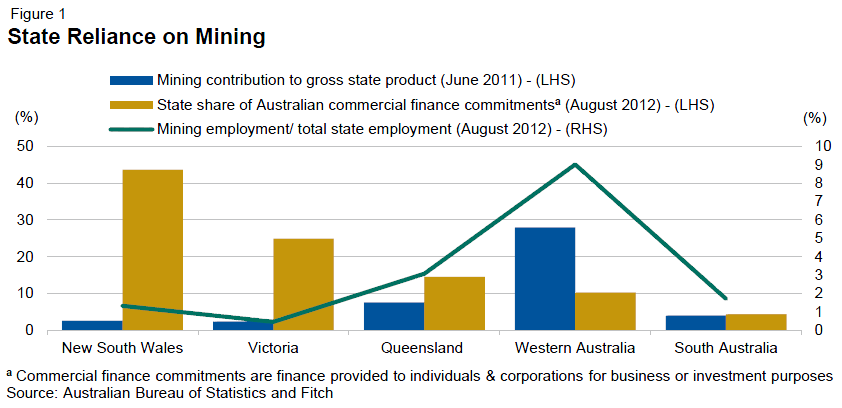Fitch is out with a report this morning examining the extent of Australian bank exposure to a mining downturn. Here is the summary:
Direct Mining Exposure Limited: Australian banks have minimal direct exposure to the mining sector despite mining accounting for about 10% of the Australian economy in the year to 30 June 2012. Larger mining companies generally satisfy their debt-funding needs through direct capital markets access, while banks are reluctant to expose themselves to the smaller, less diverse mining companies that exhibit reduced financial flexibility in lower-price conditions.
As such, lending to the mining sector accounts for less than 1% of total Australian bank lending.
Broader Economic Risk: A substantial downturn in the mining sector is likely to be felt in the broader Australian economy, as many sectors have some exposure to mining. A rise in unemployment is likely to follow, placing pressure on asset quality and leading to higher provisioning levels at Australian banks. Such a scenario is not Fitch Ratings’ base case – the agency expects Australia to grow by 3.3% in 2012, 3% in 2013 and 3.2% in 2014 – but rather represents a tail risk for the banking system.
Economic Buffers Exist: Fiscal and monetary policy retain substantial room for easing should a sharp correction have an impact on Australia. In addition, the Australian dollar would likely depreciate, providing some stimulus to export-oriented industries and those sectors competing against imports. This benefit may be less than in the past, considering global funds have increasingly invested in higher yielding currencies such as the Australian dollar.
Geographic Exposure Varies: The states of Western Australia and Queensland are the most exposed to mining – at 30 June 2011, 28% of Western Australia’s gross state product was generated by the mining sector, while in Queensland the contribution was 8% (Figure 1). In addition, Western Australian house prices have risen sharply since 2004, with the state exhibiting some bubble characteristics. Bank exposures in these states would appear to be the most susceptible should a sharp slowdown in the mining sector materialise.
Bank Buffers Improved: The buffers to absorb losses of Australia’s four major banks have increased substantially since 2008. Pre provision operating profit, collective provisions and Fitch core capital in excess of 7% of risk-weighted assets totalled AUD79bn, or more than 4% of average gross loans, for the four banks at their most recent results announcements.Funding Risks Remain: A reliance on wholesale funding, particularly from offshore markets, poses potential secondary risks for Australian banks. The banks have recognised this risk, increasing their focus on deposit gathering and maintaining much higher liquid asset holdings since 2008. Fitch expects this trend to continue, although at a modest pace due to structural issues.
All pretty sensible stuff. I will only add that we did get a taste of the last point recently. When iron sank below $95, there were several days over which Australian bank CDS prices decoupled from broader global trends and spiked all by themselves. That gives you some idea of where any bust would need to be to start making global markets nervous about rolling over funding.


